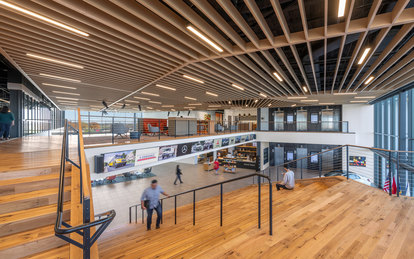CoreNet Global Hackathon: Space Utilization & Metrics in the Workplace Following COVID-19

Traditionally, corporate real estate (CRE) metrics have focused on cost and efficiency. However, in recent years we’ve seen a shift in this focus, with more companies directing large percentages of their overall capital investments towards their most valuable resource – their employees. As organizations grapple with the far-reaching impact of COVID-19—in particular, the widespread and potentially permanent adoption of remote work (in some form)—design and real estate professionals are wondering if these changes will trigger shifts in space utilization trends and the metrics used to validate return on investments. For instance, will the more recent trend of reducing square footage per employee continue? Or might organizations shift the focus of their metrics from space-centric to human-centric measurements? More importantly, if companies are forced to place even greater priority on reducing expenses, could significant business disruptions and prolonged uncertainty ushered in by COVID-19 bring transformational change in companies’ leasing strategies?
SmithGroup’s Rebecca Wanders and groupmates worked together to develop forecasts and recommendations for corporate real estate professionals navigating disruptions caused by the pandemic. What will these changes mean for space utilization and metrics going forward? The group explored a range of consideration and their impacts over three periods of time – pre-COVID-19, the transition period, and in the new normal. The group then linked the two major forces that form a business culture – the organization and its employees – to their impact on the workplace. Following is a brief summary of their findings:
- With this pandemic, we will see companies develop an even deeper commitment to employee health.
- The movement toward WELL and Smart buildings will gain traction.
- Presenteeism (when an employee is present but ill) will likely be measured, not only for its impact on productivity, but for its effect on company-wide health.
- We will see a shift in focus from measuring density to measuring adaptability. However, metrics related to density, total amount of real estate square footage in portfolios, and cost per employee will vary in use and impact over time.
- As companies struggle to control costs, utilizing space as efficiently as possible will continue to be a priority for businesses.
- Cost metrics such as total occupancy cost and cost per employee will continue to be important considerations.
- Density metrics (SF/person, peak occupancy, utilization of individual space types) will remain useful but will be toned to adjust expectations based upon relative priority.
- Workplace densities will change over time. During the pandemic and for an undetermined transition period afterwards spatial distancing measures will greatly lower densities. Eventually, density will increase. In the end, it will not likely go back to 200 SF/person but will settle at a mid-range rate.
- By implementing work from home programs, shift work and the hiring of consultants, companies will decrease their real estate needs and may be able to downsize their portfolios.
- Cost per employee will fluctuate until work from home programs become more standardized and as emerging technologies become prevalent.
- Business decisions will no longer be based solely upon workplace metrics, but holistically, leading to more comprehensive solutions.
- Companies and industries previously accustomed to operating within an established norm will be compelled to reevaluate their practices and real estate strategies to ensure support for the human experience while reconciling these changes with their bottom line.
- Staying nimble and prepared to react to and preempt the unexpected will be imperative to an organization’s long-term success.
As time marches on, organizations will continue to focus on managing expenses, increasing productivity and innovation, and attracting and retaining talent. Today, fear of contracting the COVID-19 virus has taken us to the point of isolation. However, the need to collaborate and connect will not decrease. As competition for work and talent intensifies, innovation becomes even more critical. And innovative thinking requires face-to-face collaboration.
Additional details and explanation of the team’s findings can be found here Supporting presentation can be found here.